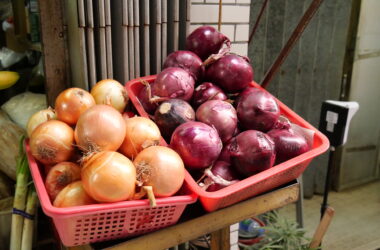Why Chives Are Kenya’s Next Big Thing
Ever wondered what crop gives you multiple harvests a year, needs minimal input, and fetches up to 400 KSh per kilo? Let me introduce you to chives farming in Kenya – the understated hustle that’s changing the agriculture game across the highlands.
Chives aren’t just another herb. They’re the subtle flavor enhancer in your favorite dishes, the purple-flowered perennial that keeps giving, and increasingly, the smart farmer’s secret weapon for consistent income. With farm gate prices that make traditional crops look like charity work and export potential that’s barely been tapped, chives are proving to be Kenya’s green gold.
This guide breaks down everything you need to know about jumping into this lucrative agricultural venture – from picking the right variety to connecting with buyers willing to pay premium prices. Whether you’re looking to diversify your farm or start your agricultural journey, chives might just be your perfect entry point.
What Exactly Are Chives?
Chives (Allium schoenoprasum) are the cool cousins in the Allium family that includes onions, garlic, and leeks. Unlike their bulkier relatives, these hardy perennials are subtle players – growing just 10-12 inches tall with round, hollow leaves that are much finer than onions. Originally from Siberia, China, or Greece, they’ve traveled the world and found a particularly comfortable home in Kenya’s highlands.
The plant grows in clumps from underground bulbs, with each bulb measuring about 2-3 cm long and 1 cm wide. What makes them instantly recognizable? Those distinctive hollow, tubular leaves and eye-catching purple flowers that aren’t just for show – they’re edible too and attract beneficial pollinators to your farm.
The best part? These aren’t one-and-done crops. Once established, a single planting can keep producing for up to three years, giving you regular harvests every 20-25 days. Talk about passive income for farmers.
The Chives Market: Numbers That Make Sense
Let’s talk cash. At the local level, farm gate prices can reach up to 400 KSh per kilogram, significantly outperforming many traditional crops. In the wholesale market, you’re looking at prices ranging from USD 2.30 to USD 4.20 per unit, with average wholesale costs hovering around KES 500 per kilogram.
The real money, though? That’s in exports. Prices can hit 300 KSh per kilogram in export markets – almost double what you’d get locally. European countries and the Middle East are particularly hungry for Kenyan chives, where demand for fresh herbs continues to grow.
According to 2023 data, the market size for fresh herbs in Kenya was estimated at around 10 billion Kenya Shillings, with chives claiming a significant slice of that pie. The increasing popularity of organic farming has created even more premium market opportunities both locally and internationally.
Chives Varieties You Can Grow in Kenya
Not all chives are created equal. Here are the varieties that thrive in Kenya’s diverse climate:
Common Chives (Allium schoenoprasum)
The MVP of Kenya’s chives scene, featuring thin, grass-like hollow leaves and those distinctive pinkish-purple flowers. They bring a mild onion flavor to the table and are primarily valued for their leaves in cooking.
Garlic Chives (Allium tuberosum)
Also known as Chinese chives, these come with flat, wide leaves and a noticeable garlicky kick. Unlike common chives, they produce white flowers and are particularly sought after for Asian cuisine.
Siberian Chives (Allium nutans)
These look similar to common chives but feature wider leaves and produce lavender flowers. They offer a slightly different flavor profile and are gaining traction among forward-thinking Kenyan farmers.
Giant Siberian Chives (Allium ledebourianum)
The heavyweight champion of the chives world, characterized by thicker leaves and taller growth than common chives. They produce pink-purple flowers and are valued for their more robust yield.
Within the common chives category, farmers can choose between fine leaf chives (thinner, smaller, and perfect for fresh use) or purly chives (with thicker leaves and higher productivity).

Setting Up Your Chives Farm: Location and Conditions
Climate Requirements
Chives are adaptable hustlers, but they do have preferences. They thrive best in Kenya’s cooler environments with temperatures between 15°C and 25°C. That said, they can tolerate a range from 10°C to 35°C, making them suitable for various regions across Kenya.
This temperature versatility is why they’re becoming increasingly popular in highland regions like Nyandarua and Nakuru, where the climate hits that sweet spot for optimal growth. Central and Western Kenya highlands offer particularly ideal growing conditions.
Soil Conditions
The herb demands well-drained, fertile soils – preferably loamy or sandy, with a pH range of 6.0 to 7.0. Soils rich in organic matter significantly boost growth and yield. While chives prefer bathing in full sunlight, they can also handle partial shade, making them adaptable to different farming setups.
Getting Started: Propagation Methods
There are two main ways to get your chives farm up and running:
Seed Propagation
You can sow seeds in nurseries or directly in the field. If starting in nurseries, transplant the seedlings once they reach about 15cm in height. Just know that seed-started plants typically develop more slowly than division-propagated plants.
Division Propagation
This is the fast track to establishment. Simply dig up existing clumps and separate smaller sections, each containing 5-10 bulbs. These divisions are then transplanted to new growing locations. This method gives you faster establishment and more uniform growth – perfect if you’re looking to start harvesting sooner.
The Planting Process
Chives are best planted in rows 30 cm apart, with individual plants spaced approximately 10-20 cm from each other. This spacing ensures good airflow and reduces competition for nutrients.
The crop requires consistent moisture, particularly around the root zone, though it’s crucial to avoid waterlogging. A drip irrigation system is ideal for maintaining appropriate moisture levels. Regular weeding is necessary, especially during the establishment phase.
For nutrients, chives respond exceptionally well to organic fertilizers and compost. A balanced fertilizer application at planting, followed by occasional side dressing, supports optimal growth and yield.
Managing Pests and Diseases
One of the major advantages of chives farming is that the crop is relatively resistant to pests and diseases compared to many other vegetables. The plant’s natural sulfur compounds act as insect repellents, making them useful as companion plants in diverse farming systems.
However, recent studies have identified emerging challenges from soil-dwelling pests in Kenya. Research conducted in 2023 found that invasive and polyphagous pests such as Atherigona orientalis and Delia platura can affect Allium crops including chives. These pests can be particularly problematic in areas with intensive vegetable production.
Currently, over 95% of Kenyan farmers rely on synthetic insecticides applied weekly or bimonthly to manage these pests, though with limited success. This highlights the need for more effective, sustainable, and affordable management strategies.
Harvesting Your Green Gold
Chives typically mature within 45-90 days after planting, depending on growing conditions and variety. Once established, they can be harvested every 20-25 days by cutting the leaves approximately 1/2 inch above the soil line, allowing for regrowth.
As a perennial crop, chives can continue producing for up to three years without replanting, making them an economically attractive option for Kenyan farmers. A greenhouse measuring 240 square meters can yield up to 150 kg of chives, providing regular income through multiple harvests.
Value Beyond The Market: Health Benefits
Chives aren’t just profitable – they’re packed with health benefits that are driving consumer demand:
- Cancer Prevention: Studies indicate that chives may have a preventive effect on cancer due to organosulfur compounds that inhibit tumor growth and prevent free radical formation. Research suggests that men with high intake of allium vegetables have a lower risk of prostate cancer.
- Brain Health: The herb contains choline, which can help with sleep problems, muscle movement, learning, and memory.
- Mental Wellbeing: Its folate content aids in preventing depression by regulating homocysteine levels in the body.
- Heart Health: Chives contain quercetin, which may reduce the risk of plaque buildup in arteries.
These health benefits are increasingly driving consumer choice, especially in export markets where health-conscious shopping is the norm.

Marketing Your Chives: Finding Buyers
The market for chives in Kenya presents significant opportunities at multiple levels:
Local Markets
Start with local supermarkets, restaurants, and hotels that are always looking for fresh, quality herbs. Urban centers like Nairobi have a growing culinary scene that values fresh ingredients.
Export Markets
The big money is in exports. European countries and the Middle East are primary export destinations, where demand for fresh herbs continues to grow. Connecting with export aggregators can help you access these lucrative markets.
Value Addition
Consider drying or freezing chives to extend shelf life and access different market segments. Value-added products can command premium prices and open additional revenue streams.
Profitability Analysis: The Numbers Breakdown
Let’s break down the economics of a small-scale chives operation:
| Item | Details | Cost/Revenue (KSh) |
|---|---|---|
| Land Preparation | 0.25 acre | 10,000 |
| Seeds/Seedlings | Quality planting material | 15,000 |
| Fertilizers | Organic and balanced fertilizers | 12,000 |
| Irrigation | Drip system installation | 25,000 |
| Labor | Planting, maintenance, harvesting | 30,000 |
| Total Investment | 92,000 | |
| Expected Yield | 500kg over multiple harvests | |
| Local Market Revenue | 500kg at average 350 KSh/kg | 175,000 |
| Potential Export Revenue | 500kg at average 500 KSh/kg | 250,000 |
| Profit (Local Market) | 83,000 | |
| Profit (Export Market) | 158,000 |
Remember, these are conservative estimates. As you scale and optimize your operations, profit margins typically improve.
Success Stories: Farmers Changing Their Lives Through Chives
Consider David from Nyandarua, who switched from maize to chives on just a quarter acre of his land. Within six months, his chives patch was generating more income than his entire 2-acre maize field, with significantly lower input costs and labor requirements.
Or Grace, who started with chives in a greenhouse measuring just 8 by 30 meters. Today, she supplies several high-end restaurants in Nairobi and has begun exporting to Dubai, building what began as a side hustle into her primary income source.
These success stories are becoming increasingly common as more farmers discover the potential of this unassuming herb.
Getting Started: Your Step-by-Step Action Plan
- Location Analysis: Identify if your farm falls within the ideal highland regions or if you’ll need to make adjustments for your specific microclimate.
- Market Research: Connect with potential buyers before planting to understand specific requirements and secure potential sales channels.
- Variety Selection: Choose the chives variety that best suits your market research findings.
- Soil Testing: Conduct a soil test to determine if amendments are needed to reach the ideal pH of 6.0-7.0.
- Propagation Decision: Decide between seed propagation (cheaper but slower) or division propagation (faster establishment).
- Irrigation Setup: Install a reliable irrigation system, preferably drip irrigation for water efficiency.
- Planting Schedule: Create a staggered planting schedule to ensure continuous harvest and supply to your identified markets.
- Post-Harvest Handling: Develop proper harvesting, cleaning, and packaging protocols to maintain freshness and quality.
The Kenyan agriculture landscape is evolving, and smart farmers are moving away from oversaturated traditional crops toward high-value, lower-input alternatives. Chives represent exactly this kind of opportunity – a chance to grow a crop that not only meets growing market demand but does so with relatively simple cultivation requirements and impressive returns.

The Future of Chives Farming in Kenya
Chives farming in Kenya represents more than just another crop option – it’s a genuine opportunity to transform agricultural economics at both small and large scales. With strong market demand both domestically and internationally, attractive pricing, and relatively simple cultivation requirements, chives position themselves as a high-value crop that can significantly enhance farmer incomes.
As the Kenyan government, in collaboration with agricultural organizations, works on improving access to high-quality seeds and training on modern farming techniques, the future of chives farming in the country looks increasingly promising.
The question isn’t whether chives farming will grow in Kenya – it’s whether you’ll be part of this green gold rush. For those willing to innovate and step away from conventional farming choices, chives offer a path to sustainable profitability that few other crops can match.
Ready to get started? The market is waiting, and the soil is ready. Your chives farming journey begins now.










